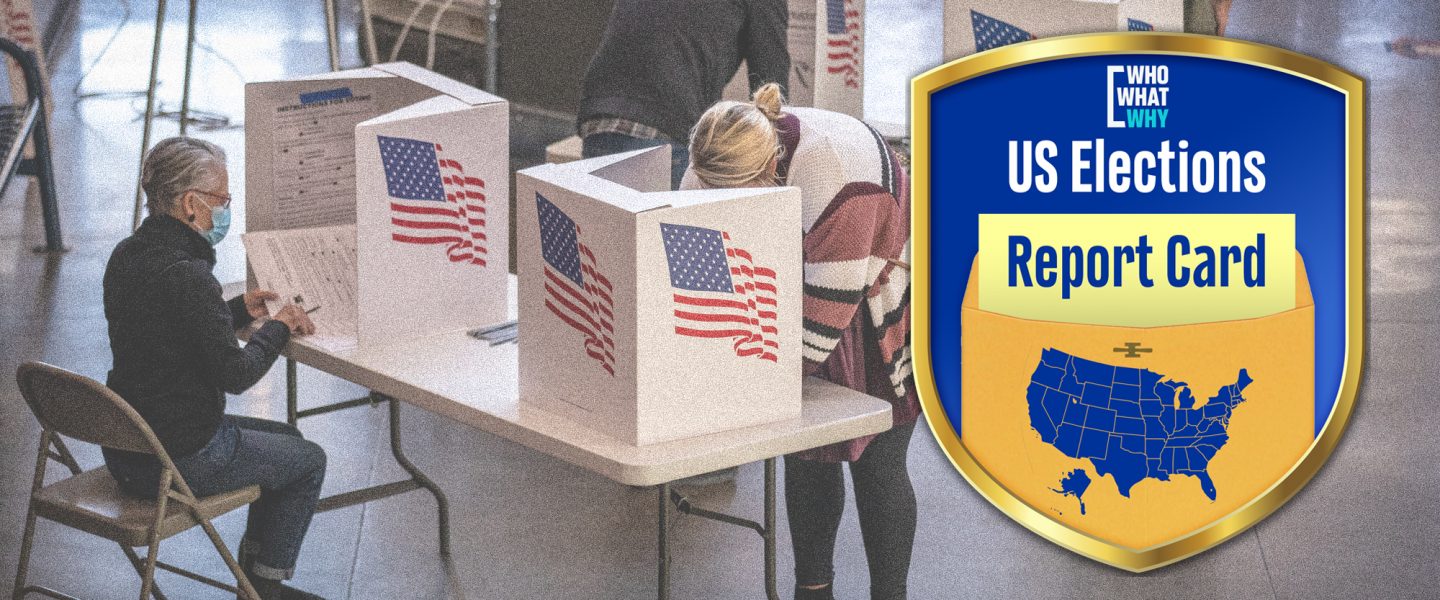WhoWhatWhy’s first US Election Report Card is a state-by-state look at the ways in which our voting system is failing democracy.
For several years now, WhoWhatWhy has been laser focused on the subject of election integrity. The US Election Report Card we publish today is a distillation of some of that work. Our senior editor Jonathan Simon is the creator of the Report Card, and in this brief podcast he gives us an overview of what it is, how it was created, and how best to use the data.
 Apple Podcasts
Apple Podcasts Google Podcasts
Google Podcasts RSS
RSS MP3
MP3
Full Text Transcript:
(As a service to our readers, we provide transcripts with our podcasts. We try to ensure that these transcripts do not include errors. However, due to a constraint of resources, we are not always able to proofread them as closely as we would like and hope that you will excuse any errors that slipped through.)
Jeff Schechtman: Thank you for joining us. Today, WhoWhatWhy has published its US Election Report Card, a look at the ways in which our voting system is failing democracy. For several years now, WhoWhatWhy has been laser focused on the subject of election integrity. And in some ways, this election scorecard is the distillation of so much of that work.
Our senior editor, Jonathan Simon, is the creator of this report card, and he joins me to give a brief overview of what it is, how it was created, and how to use the data. Jonathan, thanks so much for being here.
Jonathan Simon: Thank you, Jeff.
Jeff: Jonathan, tell us a little bit about what was the impetus for this, first of all, and then we’ll talk a bit about how it was created.
Jonathan: We knew that there’s a lot of disquiet right now about the state of and the future of democracy. I believe the numbers for voters of both parties are in the high 80s as far as concern for the future of democracy. So, it’s very much on people’s minds, and certainly in the wake of Stop the Steal, there’s been much turmoil, and a lot of open questions about the health of the democracy and how this next election is going to go, and how the 2024 election is going to go. So, there are all these problems bunched together.
And we felt that there really wasn’t one publication that gathered it all together in one place in an objective way. There’s a lot of opinion out there. We wanted to put some numbers in place and objectively measure where the democracy is now and where it may be going.
Jeff: Given that every state is different in how they conduct their elections, the way in which they conduct them, the machines on which they conduct them, the rules by which they conduct them are all different, what were some of the baselines that you looked at in putting this report card together?
Jonathan: I guess you could call it a value system in a way. What we’re valuing is participation. First of all, the ability of those who wish to participate in the democratic process by voting especially, to be able to do so without undue burden. We’re also looking at the fairness of the results of the process, how verifiable they are, the extent to which they’re audited. We’re looking at the structure, such as the redistricting or gerrymandering factor.
So, there are many, many separate measures that we’re taking, and each one has almost an intuitive value behind it – that voters should be able to participate, and that elections should be secure, and the results accepted by the public at large and by the losers of the elections.
Jeff: Tell us a little bit about how you assembled all of this data and what were some of the sources?
Jonathan: Well, there are a lot of sources out there, everything ranging from government publications to organizations like the Brennan Center and various media outlets. So, we found many different sources, sometimes multiple sources for the same thing that we’re measuring. And what we wanted to do was go and pull in that data and take our best shot at translating all that disparate data into scores that could be compared and scores that could be added up to form a total, basically a grading system. We could then translate into letter grades, so that we could give a fairly good objective impression of how the various states were doing, both in the individual areas and then as a whole.
Jeff: As you started to lay all of this out, were there some surprises that came immediately into view?
Jonathan: That’s a really good question. There are some outliers out there. There are some states that are doing remarkably poorly in certain areas, but really I’d have to say that for the most part, this set of measures confirmed something that I think is generally perceived, which is that this country has taken two very different approaches to democracy, and that those approaches, as so many other things, seem to break down along the partisan divide. So, we found a pretty strong break.
And this was not something we were looking to find, but it emerged from the data – that the red states and the purple states that are under Republican control were doing, on the whole, significantly worse, and in many cases dramatically worse, than the states that are under Democratic Party control.
Jeff: Was there any geographical component? Certainly, there’s a lot of red states in the South with their similarities there: Were those red states different than red states and other parts of the country, for example?
Jonathan: No. I’d say that it divides somewhat geographically, but primarily because of the concentration of red and blue states – obviously, the coastal New England area, California and such – so there’s a correlation between the geography and the partisanship. But beyond that, no, it really was not regional. And we’re looking at states nationwide that really were restricting participation, were low in turnout, placed a lot of burdens on voters, where election workers were facing more threats and less protection of their safety, where audits weren’t as good, where a lot of election deniers were running for public office.
We found that that pretty much transcended regional considerations, and really was much more aligned with partisan considerations. So, for instance, you could have a state like Florida scoring very low. It’s a swing state, but it’s basically run by Republicans in the legislature, and the governor of course. You can have that matched up with Arizona, or Idaho, or Ohio, as low scores, and the key determinant seemed to be who was making the laws, who was determining how the elections would function and, more broadly, how the democracy would function.
Jeff: Among states that might have gotten an F, among certain red states, were there variations in what caused that F? And if so, how did you incorporate that into the report card?
Jonathan: Yes, there were variations, but what I have to say is that the Fs really didn’t come from one or two failings They represented, for the most part, multiple failings in many of the categories we looked at. We looked at 12 principal metrics, or 12 principal categories of measure; and within those there were 43 subcategories. So, this was pretty comprehensive. I wouldn’t say perfect. I wouldn’t say we were able to look at everything or look at everything in the same way, but it certainly generates a pretty clear impression.
And the states that failed, failed because they were basically coming up short in category after category. There were the occasional points of light, even in states that failed and didn’t do well, but it was predominantly states that were restricting participation, that weren’t restoring the rights of felons, that had legislative activity that we regarded as anti-(small d)-democratic, that had court decisions that were not favorable for democracy. It really was pretty much across the board.
Jeff: Among the states, who did the best?
Jonathan: Well, we had some states at the top that did fairly well. California, Colorado did well. Washington and Oregon did well. These are blue states. They have vote by mail, and in many cases they have more opportunities to vote, longer early voting periods, less in the way of burdensome ID requirements. They have more drop boxes per capita, et cetera, et cetera. And that led to pretty high grades in those areas.
And the highest grade we had was still below an 80; 100 would’ve been a perfect score. And frankly, we weren’t expecting perfect scores. I mean, these are a lot of metrics and there’s going to be some falloff from what we would regard as the perfect state democracy-wise. But these were the highest scores, and then it dropped all the way down. In the case of Alabama, I believe the score was 24.2. So this is a long spectrum on the 0 to 100 scale. We’re basically ranging from the mid-20s to almost 80.
Jeff: For somebody who wants to plunge in and examine the report card, and really dig in and spend some time with this, talk a little bit about what that experience will be like and how long it’s going to take them.
Jonathan: So the way we conceived this project was on multi-levels and, in a way, to serve both masters: the big picture and the details. When you look at the map – the colorful map with the grades and the numerical scores – you get a really big-picture view of the rank of the states, of how they are all doing together, what the national picture looks like, and what each state looks like.
That’s basically the top level. And it gives you something like a pointillist picture of “The Scream.” But it has layers and you can root around in those layers. So when you click on the map, you can go down to the individual categories that we use to measure things, like audit protocols and election deniers running for office and redistricting – all those 12 major categories. And you can see how each state did on each one of those categories.
And then you can go even a little bit further down to a level of sub-components. And there were 43 of these sub-components of these major categories. So you can get quite specific about how each state is doing in each area that bears on elections and on democracy. And also at that level, we have the sources for the data and the information, and we have legends that explain where these numbers, our scores, came from. They didn’t come out of thin air.
So there’s a real trove here. It’s a smorgasbord. But if your time is limited, you can look at the top and get a pretty strong impression about what’s going on in the country. And then if you have more time and more curiosity about it, you can probe down further into the nitty-gritty and the details of it.
Jeff: What do you hope people take away from this in terms of information that might not have been available to them elsewhere?
Jonathan: Well, I think it gives you a bird’s eye view and a good snapshot. We graded on the curve, and so we were able to come up with some As, but there are relatively few As and Bs. More than half the states wound up with Ds and Fs. So there’s trouble in the states, and the other aspect of that is it’s doing far worse in certain states than others.
And that really highlights a crying need for federal legislation (and possibly amendments) that begin to bring some positive change, and uniform standards for democracy, to the country as a whole, whatever state you live in. And unfortunately, we seem to be going in retrograde when it comes to that, at least in terms of Supreme Court decisions and some of the other decisions coming out of the federal courts – weakening the Voting Rights Act, permitting partisan gerrymandering, et cetera.
And we suspect in the upcoming term, making it even easier to gerrymander along racial lines, as well as partisan lines, and possibly the Moore v. Harper case, potentially empowering state legislatures with almost total power, unfettered by state courts, to change the rules for conduct of an election, to possibly overturn the results of elections.
But at the federal level, legislation that has been proposed has been subject to the filibuster. It has not passed. It’s really been a vacuum. And the idea has been to leave elections to the states. And we’re seeing what’s happening, which is that America as a whole is not doing well. And we also have two Americas out there, where a good part of America is doing abysmally.
Jeff: And finally, you’ve been doing this work a long time. You’ve been looking at these issues for a long time. If you had done this report card 10 years ago, 15 years ago, would it have been similar or would it have been better?
Jonathan: Ooh, that’s a tough hypothetical. I suspect it would have been better. Because in the past 10 or 15 years, we’ve had some very, very damaging decisions by the Supreme Court. They haven’t all been damaging. I mean, they’ve supported democracy on occasion, but the balance has been towards permitting more money in elections (more dark money, of course, unlimited amounts); opening up the gates for gerrymandering; striking down sections of the Voting Rights Act, which was a very, very key piece of legislation in protecting elections and protecting voters and protecting democracy.
And then just in the last couple of years, we’ve had a flurry of legislation, and administrative rulings as well, that have been supposed response to an “epidemic” of “voter fraud,” for which there’s truly zero evidence. But that has been the pretext. It has further restricted the franchise, tightened up and targeted restrictions. If not blatantly targeted, then in effect pragmatically targeted certain voting groups – voters of color, young voters, voters in urban areas – targeted them for various disenfranchisement– I’ll call them schemes. They take the form of laws and regulations, but it’s pretty clear what their intent is.
And elections were never perfect. Our democracy was never perfect. But the spate of court decisions and legislation has really been taking us in retrograde. And I suspect that if we had done this survey and this report and gathered this kind of data 10 or 15 years ago, we would have had fewer states with abysmal failing grades, and the state of democracy as a whole in the country would have been better.
Jeff: Jonathan Simon, I thank you, and we all look forward to looking at the Elections Report Card.
Jonathan: Thanks very much, Jeff. It should be of great interest to many people who are concerned about what is going on in the country with respect to elections, and really that’s going to determine what’s going on in the country with respect to whether we can preserve a functioning democracy.
Jeff: Jonathan, thank you, and I’m sure we all look forward to digging in on this US Elections Report Card.



